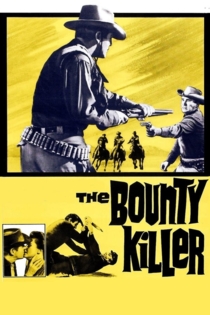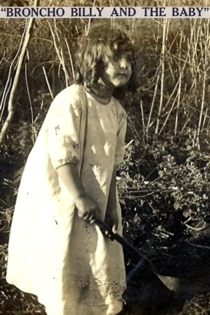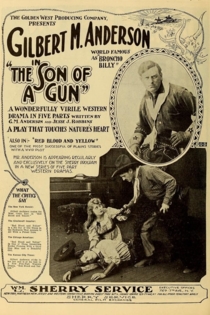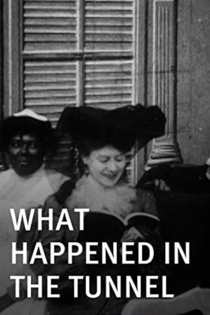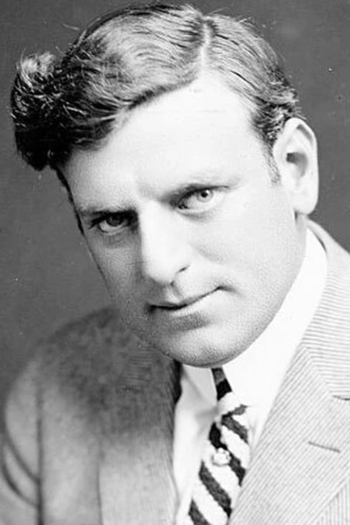
Gilbert M. Anderson
1880 - 1971He retired for the first time in 1916 but made a few comebacks, including producing movies into the 1950s for his company, Progressive Pictures. He received an honorary Oscar in 1958 as a “motion picture pioneer.” Anderson came out of retirement one more time for a cameo in 1965’s “The Bounty Hunter.” He died at age of 90 1971.
Broncho Billy's Redemption
Gilbert M. Anderson
Gilbert M. Anderson, Clara Williams
A wanted cattle thief risks imprisonment when he tries to help a sick rancher and his daughter. He takes the man into town to see a doctor, and he is recognized and arrested.
Broncho Billy's Redemption

The Film Parade
J. Stuart Blackton
Kent Stevenson, Charlie Chaplin
Pioneer filmmaker J. Stuart Blackton was intrigued by the idea of a film about the history of the movies as early as 1915. He finally released a 52-minute feature called The Film Parade that was shown in New York and favorably reviewed by "Variety" in 1933. He continued tinkering with the film for the rest of the decade, and later filmmakers and distributors used Blackton's footage for stock or to produce their own variously titled and truncated versions. -UCLA Film & Television Archive
The Film Parade
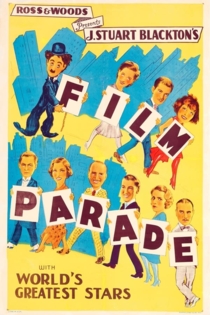
The Dancing Nig
Gilbert M. Anderson
A darkey finds it impossible to keep his feet still whenever he hears the sound of music. Sam is enticed from his home by hearing the sound of mouth harps played by two of his friends; out of the window he comes. He then gets a job to carry a trunk, an organ-grinder starts his feet a-going; he gets a job as waiter, the orchestra does the balance. Then he becomes a porter, the Dutch band finishes him with this position; then a barber, an artist's model and other positions, from all of which he is promptly fired because he can't keep his feet still when the strains of music float in the air.
The Dancing Nig

The Great Train Robbery
Edwin S. Porter
Gilbert M. Anderson, John Manus Dougherty Sr.
After the train station clerk is assaulted and left bound and gagged, then the departing train and its passengers robbed, a posse goes in hot pursuit of the fleeing bandits.
The Great Train Robbery

Broncho Billy's Capture
Gilbert M. Anderson
Gilbert M. Anderson, Evelyn Selbie
Juan Yukas, a greaser, schemes with his sweetheart, Evelyn, to hold up the stage and rob the driver of the express box. Broncho Billy is infatuated with Evelyn, The coach is held up. Broncho Billy captures Juan and takes him to Evelyn's shack, to get a drink of water. Evelyn betrays herself. Although he loves her, his duty compels Broncho Billy to take Evelyn prisoner.
Broncho Billy's Capture

Shootin' Mad
Jess Robbins
Gilbert M. Anderson, Fred Church
A settler and his daughter are trying to homestead a plot of land. They are tricked out of the land by a crooked saloon owner, who then shoots the father and makes a play for the daughter. A local cowboy comes to her rescue.
Shootin' Mad
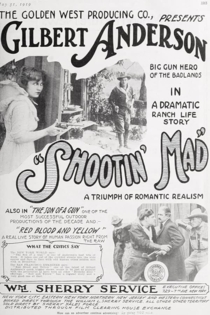
Why Broncho Billy Left Bear County
Gilbert M. Anderson
Gilbert M. Anderson, Marguerite Clayton
Through a kindly act Broncho Billy earns the deep gratitute of Marion Rivers, who presents him with a Bible. Not long afterwards, she comes upon him as he is about to hold up the stage, but at sight of the girl he is overwhelmed with shame and taking out the little Bible promises her that he will live honorably. In the meantime, Marion's father holds up the stage at another point, and one of the stagecoach drivers, mounting a bareback pony, rides off for the sheriff. Broncho Billy sees Rivers get away with the money, and when he hears the sheriff and his men coming, for Marion's sake he goes to warn her father. To shield him, he takes the bags of money and rides away with the men after him. He leaves the money at the mile post with a note saying: "SAheriff, I'm through with Bear County, this stick-up was my last", and rides across the border. (Moving Picture World Synopsis)
Why Broncho Billy Left Bear County
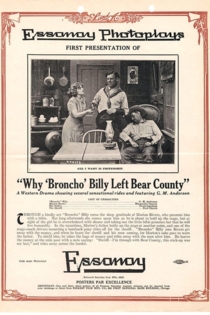
The Making of Broncho Billy
Gilbert M. Anderson
Gilbert M. Anderson, Brinsley Shaw
Broncho Billy runs into trouble in a bar when he gets into a confrontation with a bully. Since the bully has a gun and Billy doesn't, he's forced to endure the bully's humiliating tactics until he manages to get away. He determines to find himself a gun, learn how to use it and then go back and find the bully for a little payback.
The Making of Broncho Billy
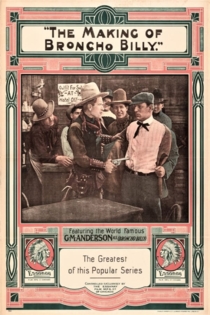
The Pest
Gilbert M. Anderson
Stan Laurel, Glen Cavender
Stan is Jimmy Smith, a salesman who is trying hard to pitch his Napoleon book to an uninterested customer as they stand in front of some iron gates. When an elderly gentleman approaches the two men he uses sign language to communicate to the 'customer' and they leave together. This is when Stan sees the sign for the Deaf & Dumb Institute that his subject was standing in front of. An elderly lady then walks out of the gates and Stan uses sign language in an attempt to talk to her. Of course, she is not deaf or dumb and gives him some verbal abuse for assuming so.
The Pest

The Movies March On
Alan Brown
Renée Adorée, Gilbert M. Anderson
A "March of Time" presentation of the evolution of movies compiled primarily from film clips of silent movies through the early sound pictures to the present (1939) date. Industry executives such as Jack and Harry Warner, Walt Disney, Cecil B. DeMille, et al are seen taking bows in the live (non-archive) footage.
The Movies March On

The Bounty Killer
Spencer Gordon Bennet
Dan Duryea, Rod Cameron
Willie Duggans, a tenderfoot from the east, arrives in the wild west and soon experiences its violence. Willie discovers the easy money in bounty killing and must choose between that violent lifestyle and the love of a beautiful saloon singer.
The Bounty Killer
